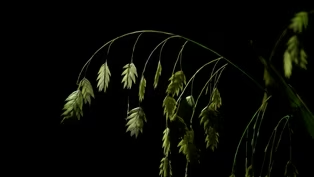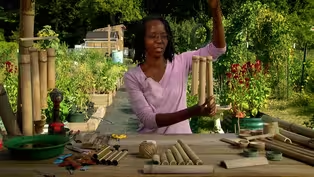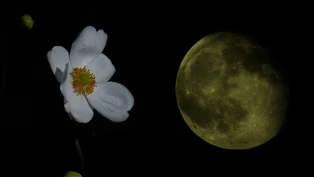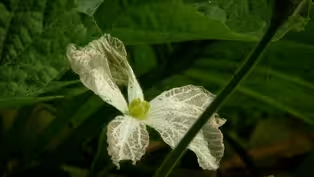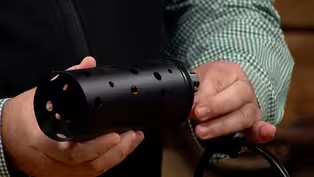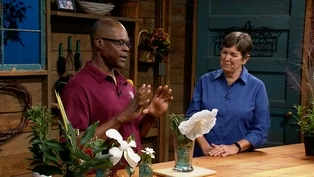Virginia Home Grown
The Moon Garden
Clip: Season 25 Episode 7 | 7m 36sVideo has Closed Captions
Visit a garden full of native plants designed to be enjoyed at night
Dr. Robyn Puffenbarger explores The Moon Garden in Waynesboro and talks with Lucy Ivey about the garden design and how it has evolved to focus on native plants. Featured on VHG episode 2507, September 2025.
Problems playing video? | Closed Captioning Feedback
Problems playing video? | Closed Captioning Feedback
Virginia Home Grown is a local public television program presented by VPM
Virginia Home Grown
The Moon Garden
Clip: Season 25 Episode 7 | 7m 36sVideo has Closed Captions
Dr. Robyn Puffenbarger explores The Moon Garden in Waynesboro and talks with Lucy Ivey about the garden design and how it has evolved to focus on native plants. Featured on VHG episode 2507, September 2025.
Problems playing video? | Closed Captioning Feedback
How to Watch Virginia Home Grown
Virginia Home Grown is available to stream on pbs.org and the free PBS App, available on iPhone, Apple TV, Android TV, Android smartphones, Amazon Fire TV, Amazon Fire Tablet, Roku, Samsung Smart TV, and Vizio.
Providing Support for PBS.org
Learn Moreabout PBS online sponsorship>>I have always wanted to have a Moon Garden.
And the whole center of this garden is a grass circle, which is in the shape of a full moon.
And it's surrounded by plants that were originally either white or night flowering or fragrant, or pale, which is the idea of a Moon Garden, so that they catch the moonlight and reflect it.
My husband and I moved down here from Afton.
When we moved into this house, this lot, which was an extra lot next to the house, was one flat yard.
And I got it into my head that I wanted to start doing some native plant gardening, but I wasn't the gardener, my husband was.
He, though, had done a life of construction and could no longer really garden.
So gardening was up to me.
I got a gardening company to help me build the garden.
>>And we're sitting here under an incredibly beautiful semi-circle pergola.
>>I can't really describe to you how they bent the wood.
And you can see these pegs are hand hewed and driven into it.
It involved the cooperation of the landscaping company and a woodworking company.
And the idea of the pergola was you would sit out here in the night and enjoy the moon passing over the garden.
So here's this glorious sky that you're supposed to do that.
Unfortunately I got it a little bit wrong and there's only about a week in the month when the moon passes over this garden, when the sky is dark enough and we're actually awake.
But it is glorious when that does happen.
>>But I think you enjoy this space much more than just when the moon is going over.
>>Yeah, because actually, the moon circle is so large that it's hard for it to pick up these and reflect off the flowers.
But it is a perfect place to have coffee in the morning, to eat out here with friends.
And also it's wonderful when there're children 'cause they just love to go out there and dance and look like little fairies dancing around.
>>I think a lot of people don't think about plants going up unless they're trees.
But what all do you have growing on this?
>>So I planted them behind the columns and they're all native vines, Virginia Creeper on the outside, then Coral Honeysuckle.
And there is a Purple Passion flower vine growing up the last one.
And because it began to take over the whole garden, we ended up trying to pull it all out.
But I miss it.
It gets the most wonderful fruit and has the most beautiful flowers.
After seven years of summers, the fruit was finally delicious to eat.
It wasn't just empty seeds inside.
It was really wonderful, flavorful fruit.
>>So, one of the things that's traditional about a Moon Garden is fragrance.
And I'm not sure I see a lot of fragrant plants right now.
Is it a time of year thing?
>>Well, you know, it's difficult to get a lot of native plants that are really fragrant.
We have the mountain mints and they are, and then surrounding this garden, but not actually in it are a few fragrant trees that flower.
Virginia Magnolia, apple tree was fragrant in the spring.
That's not native.
The sweet pepper bush is fragrant and the Virginia Sweetspire is fragrant.
So unless I wanted to bring in a lot of non-native plants, that's one element that's sort of lacking from this Moon Garden.
>>But you have lots of pollinators.
>>Yes.
So really this is a splendid pollinator garden.
And the wonderful thing about this year, as opposed to last year, is that because there's been rain, it has been a year full of flowers, which of course pollinators love.
They first started coming with the shrubby St.
John's wart, which was covered with bees.
And then they move on to the Mountain Mints when they started flowering.
Now they're in the Obedient Plant.
So they have just been racing through all the plants.
Oh yeah.
The milkweeds, there've been mostly bees in this garden.
I have lots of native bees.
There's Dog Bane down in the lower field and that beautiful dog bane beetle.
>>Yes.
>>Is much more beautiful than the Japanese beetle.
>>Saw lots of skippers >>Yes.
>>Tonight.
>>And this year, unlike last year, even the year before, I've had plenty of monarchs flying through and I have pawpaw trees now, but I have yet to see a zebra swallow tail.
>>It may take a few years.
>>Yeah.
>>As we were looking around, though, there's a lot of pollinator plants.
You've kept a lot of really great things.
>>Well, there are hundreds of species in this garden, not just forbs, but there are plenty of species of trees and shrubs.
But there are a few successful native plants that have really taken over, like the ones right behind us, which have the common name of Shale Barren Asters.
And they are so successful.
We have actually spent this entire summer trying to replace some of them with worthy competitors so that we, I don't end up with a monoculture in this garden.
>>And I see you have some Mountain Mint.
>>Yes.!
Now isn't the original Mountain Mint.
There were three plants back up in there.
And it really features one of the things that's so wonderful about native plants, which is that they spread themselves all over the garden.
And one year you'll have them up here and the next year you'll have them elsewhere.
So this year they formed themselves right here in front, which is really nice when the moon comes over this garden.
>>So nice when natives work out that way.
So it sounds like one of the themes of your eight years of gardening is you build it and they will come.
>>Yeah.
>>And they will spread themselves and it will evolve and change sometimes to your liking and sometimes not.
>>Yeah, this year has been really lucky 'cause we had plenty of rain for most of the summer.
But native plants do really well in most drought situations.
But last summer we had months of drought and they really suffered for it.
>>But, like you said, they've come roaring back.
>>That was the good news, is that they don't die.
They don't, you know, give up the ghost, they hang on.
Their roots go really deep into the soil and so if you can shield the soil and part of what shields the soil is the fact that they grow so tall so they shade themselves.
So even if they don't flower abundantly, they protect the future for themselves.
>>So just give it some time.
>>Yeah.
>>And you'll see it again.
>>Yeah.
>>Well, thank you so much for having us here to enjoy this incredibly beautiful space.
>>Thank you, Robyn.
>>Right in downtown.
>>It's been my pleasure.
Clippings: The Nighttime Garden
Video has Closed Captions
Clip: S25 Ep7 | 26m 46s | Explore the garden after dark! (26m 46s)
Video has Closed Captions
Clip: S25 Ep7 | 3m 35s | Calming sounds benefit your garden day or night (3m 35s)
Video has Closed Captions
Clip: S25 Ep7 | 8m 8s | Learn why a day and night cycle is just as important to plants as it is to us (8m 8s)
Night Pollination in the Vegetable Garden
Video has Closed Captions
Clip: S25 Ep7 | 2m 43s | Pollination occurs around the clock in our gardens (2m 43s)
Responsible Landscape Lighting
Video has Closed Captions
Clip: S25 Ep7 | 6m 18s | Learn how to reduce glare and enhance your garden lighting design (6m 18s)
Traditional Moon Garden Plants
Video has Closed Captions
Clip: S25 Ep7 | 6m 23s | Discover the characteristics of plants for night time gardens (6m 23s)
Providing Support for PBS.org
Learn Moreabout PBS online sponsorship

- Home and How To

Hit the road in a classic car for a tour through Great Britain with two antiques experts.












Support for PBS provided by:
Virginia Home Grown is a local public television program presented by VPM
